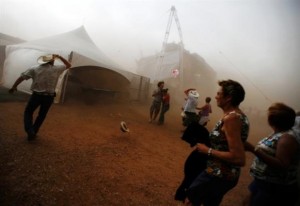He says even if someone isn’t selling alcohol, they could potentially be liable if they’re hiring the vendors, but points out that most venues routinely work with the same caterers and other vendors, which helps in drafting a contract.
Nuccio says photography insurance is also popular. If a photographer runs off or disappears without coughing up a wedding album, this policy brings the wedding party back together with the same clothes, cake and venue to restage the event.
Things get even more complicated at bigger venues, such as a concert, music festival or an art fair—basically any large gathering of people offers the potential for injuries and lawsuits.

In November 2008, there was a semi-collapse of the stage at Dodger Stadium where Madonna and Britney Spears were scheduled to perform.
On July 16, 2009, Madonna was scheduled to perform at the Velodrome stadium in Marseille, France. The roof of the stage collapsed when a crane gave way killing two people and injuring 10 workers. The concert was subsequently cancelled. The same company that had built the collapsed stage at Dodger Stadium, also constructed the stage at the Velodrome.
On August 1, 2009, a woman was crushed to death from a stage collapse at the Big Valley Jamboree, a country music festival held near Edmonton, Alberta. In that collapse, 75 people were injured and two people were left in critical condition. This time, a number of people were trapped underneath the stage including actor Kevin Costner whose band “Modern West” was due to perform. A severe storm caused the collapse with reports that a tornado had touched down near the festival.
In July 2011, a stage collapsed at Canada’s Ottawa Bluesfest while the band “Cheap Trick” was performing. A violent thunderstorm caused the collapse. Five people suffered injuries.
On August 8, 2011, the stage collapsed at the Brady Block Party in Tulsa due to a torrential downpour and high winds before the band “Flaming Lips” was about to take the stage. No one was injured.
On August 13, 2011, seven people were killed and 58 people were injured when the stage suddenly collapsed at the Indiana State Fair. The collapse occurred seconds before the country band “Sugarland” was scheduled to perform. The collapse was due to wind gusts that were reported to be 60 to 70 mph. Several lawsuits are currently pending.
In August 2011, three people died and 71 people were injured when a stage collapsed during a storm at an outdoor alternative-rock festival in Hasselt, Belgium near Brussels.
Any venue should have a general liability policy, which Schmickle calls the “bread and butter” of commercial liability. It covers the event organizers for any lawsuits arising from injuries or property damage due to negligence of the insured—anything from a trip and fall to a stage collapse.
From there, an organizer could consider any number of additional coverages such as auto insurance, liquor insurance or crime coverage, in case someone runs off with the ticket box.
Schmickle says a primary liability policy will typically include coverage of $1 million to $2 million. Anyone needing more than that could consider an additional excess policy that would cover liabilities of up to $50 million, depending on the size of the event.
“Imagine you had 200,000 people at a festival and there was a stampede riot, you would have tens of millions of dollars in claims,” Schmickle says. “That would cover that.”
In many cases, liability comes down to more of a contractual issue rather than one of insurance, especially in case of a lawsuit. A city has a contract with a promoter, who has contracts with multiple vendors, such as set-up crews, security teams, food carts and beer tents.
All of these suppliers will tie their liability together to segregate the risk, with the promoter making sure each vendor has enough liability coverage and that the contract spells out who is responsible for mishaps and whose insurance would provide the primary coverage.
“If a vendor is responsible for a trip and fall they’re going to be held accountable although the promoter may be named, there’s a contract between them and federal and state laws usually decide who is going to trial by that contract,” Schmickle says. “It’s spelled out and it’s spelled out a million ways from Sunday. Essentially a contract is what’s going to be reviewed by a judge and then the judge is going to say these parties aren’t responsible and they will be dropped from the lawsuit and the lawsuit will go forward with these entities.”
Schmickle estimates that 75 percent of public events involve alcohol, which serves up a regulatory nightmare for event organizers as liquor control laws vary by state. In some locations, a license is required to dispense or sell alcohol. In others the promoter is allowed to collect receipts without a license.
Since liquor liability insurance is excluded from general coverage, a special policy is needed regardless of where the event is held. Schmickle says he’s never heard of a facility not requiring such a policy.
Aside from parties and festivals, liability can also enter all matters of public events, such as a three-on-three basketball tournament or a skateboarding expo. Schmickle says such an event would need an accidental medical policy to cover the participants and the volunteers, as they would likely be excluded from the event’s general liability insurance.
Even if everyone involved were to sign a waiver of liability, Schmickle says the laws on these differ by state so such a document might not hold up in court.
Nuccio says any public event should have liability coverage, whether it’s a booster club holding a car wash, a nonprofit carnival or even a bridge club—all of which he’s written several policies for.
“What can happen at a bridge club you’d say? Well, not too long ago a guy pushed his chair back and he didn’t see there was an older lady standing behind him and he pushed her down, she broke both of her hips— which cost $278,000, later she had double hip replacement, now who would’ve thought? From a bridge club game?” Nuccio says. “But you know what? This is the United States and if you hurt someone, end of story you’re going to get sued, that’s all there is to it.”
Reaching for an umbrella
Wharry says it’s important for people to be aware of the limits of their insurance coverage and to consider an umbrella policy—which provides an additional layer of liability protection in excess of their homeowner’s insurance.
Anspach says an umbrella policy makes sense for anyone whose assets exceeds their homeowner’s policy. He says some insurance agents provide audits to analyze what assets a policyholder has and compare it against their total coverage.
“Say your homeowner’s policy is for $500,000 and you’ve got $2 million in other assets, property, artwork, money markets, then it’s definitely a good idea to have an umbrella policy up to the amount of your net worth and beyond,” Anspach says. “If somebody slips and falls on the banana peel and they become a paraplegic and they sue you, all your assets will be protected.”














